air filter TOYOTA PROACE 2019 Owners Manual (in English)
[x] Cancel search | Manufacturer: TOYOTA, Model Year: 2019, Model line: PROACE, Model: TOYOTA PROACE 2019Pages: 516, PDF Size: 90.91 MB
Page 10 of 516
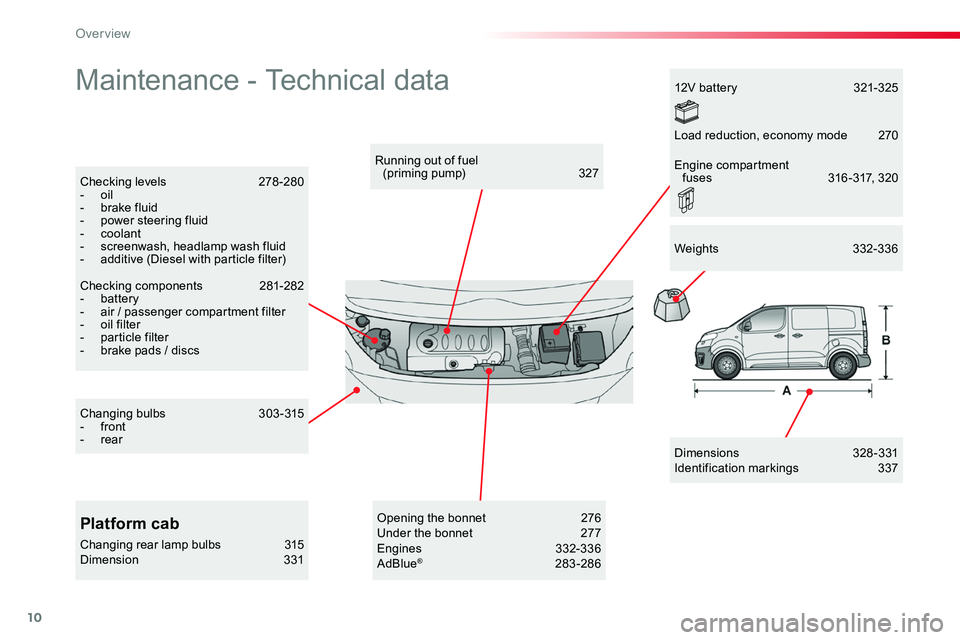
10
Maintenance - Technical data
Dimensions 328-331Identification markings 337
Running out of fuel (priming pump) 327Checking levels 278 -280- oil- brake fluid- power steering fluid- coolant- screenwash, headlamp wash fluid- additive (Diesel with particle filter)
Checking components 281-282- battery- air / passenger compartment filter- oil filter- particle filter- brake pads / discs
Changing bulbs 303-315- front- rear
Platform cab
Changing rear lamp bulbs 315Dimension 331
12V battery 321-325
Opening the bonnet 276Under the bonnet 277Engines 332-336AdBlue® 283-286
Weights 332-336
Load reduction, economy mode 270
Engine compartment fuses 316 -317, 320
Over view
Page 13 of 516
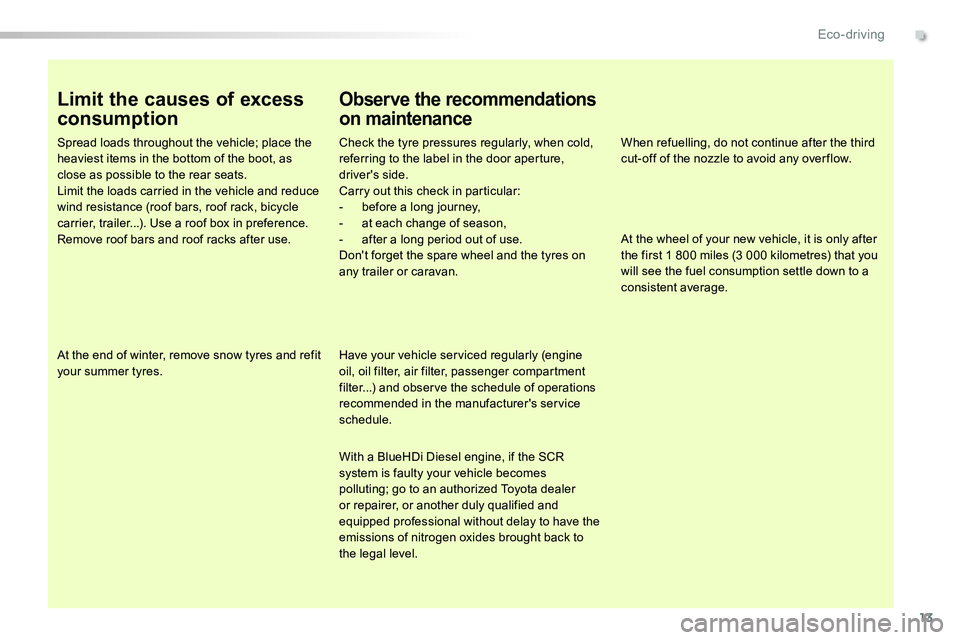
13
Limit the causes of excess
consumption
Spread loads throughout the vehicle; place the heaviest items in the bottom of the boot, as close as possible to the rear seats.Limit the loads carried in the vehicle and reduce wind resistance (roof bars, roof rack, bicycle carrier, trailer...). Use a roof box in preference.Remove roof bars and roof racks after use.
At the end of winter, remove snow tyres and refit your summer tyres.
Observe the recommendations
on maintenance
Check the tyre pressures regularly, when cold, referring to the label in the door aperture, driver's side.Carry out this check in particular:- before a long journey,- at each change of season,- after a long period out of use.Don't forget the spare wheel and the tyres on any trailer or caravan.
Have your vehicle serviced regularly (engine oil, oil filter, air filter, passenger compartment filter...) and observe the schedule of operations recommended in the manufacturer's service schedule.
With a BlueHDi Diesel engine, if the SCR system is faulty your vehicle becomes polluting; go to an authorized Toyota dealer or repairer, or another duly qualified and equipped professional without delay to have the emissions of nitrogen oxides brought back to the legal level.
When refuelling, do not continue after the third cut-off of the nozzle to avoid any over flow.
At the wheel of your new vehicle, it is only after the first 1 800 miles (3 000 kilometres) that you will see the fuel consumption settle down to a consistent average.
.
Eco-driving
Page 20 of 516
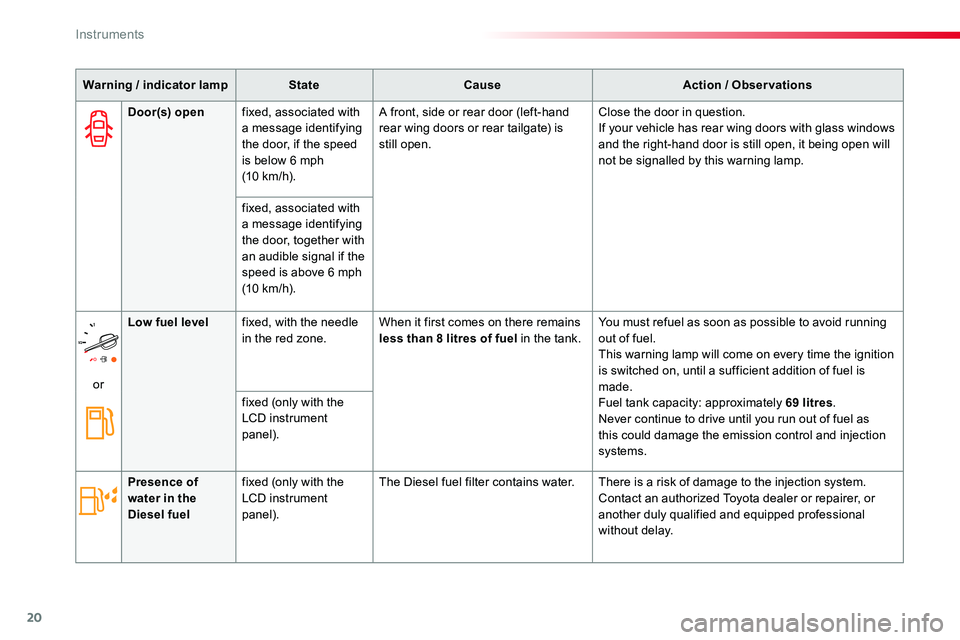
20
Warning / indicator lampStateCauseAction / Observations
Door(s) openfixed, associated with a message identifying the door, if the speed is below 6 mph (10 km/h).
A front, side or rear door (left-hand rear wing doors or rear tailgate) is still open.
Close the door in question.If your vehicle has rear wing doors with glass windows and the right-hand door is still open, it being open will not be signalled by this warning lamp.
fixed, associated with a message identifying the door, together with an audible signal if the speed is above 6 mph (10 km/h).
or
Low fuel levelfixed, with the needle in the red zone.When it first comes on there remains less than 8 litres of fuel in the tank.You must refuel as soon as possible to avoid running out of fuel.This warning lamp will come on every time the ignition is switched on, until a sufficient addition of fuel is made.Fuel tank capacity: approximately 69 litres.Never continue to drive until you run out of fuel as this could damage the emission control and injection systems.
fixed (only with the LCD instrument panel).
Presence of water in the Diesel fuel
fixed (only with the LCD instrument panel).
The Diesel fuel filter contains water.There is a risk of damage to the injection system.Contact an authorized Toyota dealer or repairer, or another duly qualified and equipped professional without delay.
Instruments
Page 23 of 516
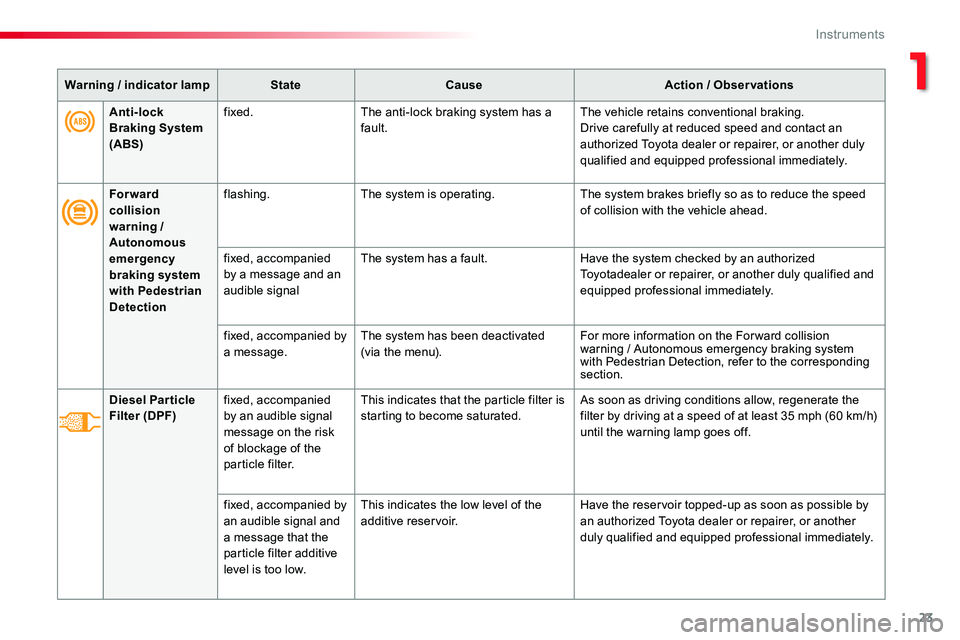
23
Anti-lock Braking System (ABS)
fixed.The anti-lock braking system has a fault.The vehicle retains conventional braking.Drive carefully at reduced speed and contact an authorized Toyota dealer or repairer, or another duly qualified and equipped professional immediately.
Warning / indicator lampStateCauseAction / Observations
For wardcollisionwarning /Autonomousemergencybraking systemwith PedestrianDetection
flashing.The system is operating.The system brakes briefly so as to reduce the speed of collision with the vehicle ahead.
fixed, accompanied by a message and an audible signal
The system has a fault.Have the system checked by an authorized Toyotadealer or repairer, or another duly qualified and equipped professional immediately.
fixed, accompanied by a message.The system has been deactivated (via the menu).For more information on the Forward collision warning / Autonomous emergency braking system with Pedestrian Detection, refer to the corresponding section.
Diesel ParticleFilter (DPF)fixed, accompanied by an audible signal
message on the risk of blockage of the particle filter.
This indicates that the particle filter is starting to become saturated.As soon as driving conditions allow, regenerate the filter by driving at a speed of at least 35 mph (60 km/h)
until the warning lamp goes off.
fixed, accompanied by an audible signal and a message that the particle filter additive level is too low.
This indicates the low level of the additive reservoir.Have the reservoir topped-up as soon as possible by an authorized Toyota dealer or repairer, or another duly qualified and equipped professional immediately.
1
Instruments
Page 28 of 516
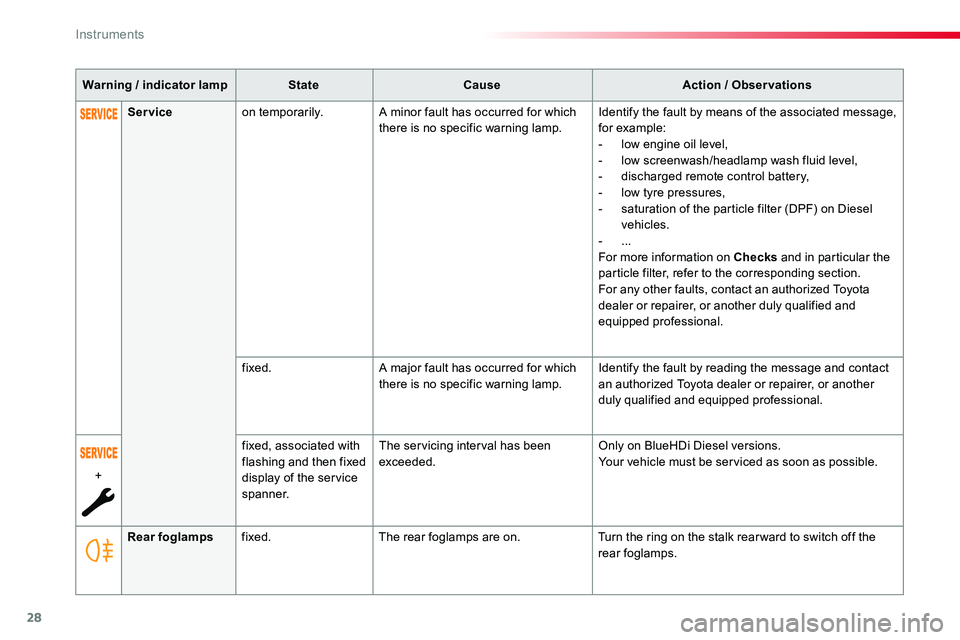
28
Warning / indicator lampStateCauseAction / Observations
Rear foglampsfixed.The rear foglamps are on.Turn the ring on the stalk rear ward to switch off the rear foglamps.
Serviceon temporarily.A minor fault has occurred for which there is no specific warning lamp.Identify the fault by means of the associated message, for example:- low engine oil level,- low screenwash/headlamp wash fluid level,- discharged remote control battery,- low tyre pressures,- saturation of the particle filter (DPF) on Diesel
vehicles.- ...For more information on Checks and in particular the particle filter, refer to the corresponding section.For any other faults, contact an authorized Toyota dealer or repairer, or another duly qualified and equipped professional.
fixed.A major fault has occurred for which there is no specific warning lamp.Identify the fault by reading the message and contact an authorized Toyota dealer or repairer, or another duly qualified and equipped professional.
+
fixed, associated with flashing and then fixed display of the service spanner.
The servicing interval has been exceeded.Only on BlueHDi Diesel versions.Your vehicle must be serviced as soon as possible.
Instruments
Page 135 of 516
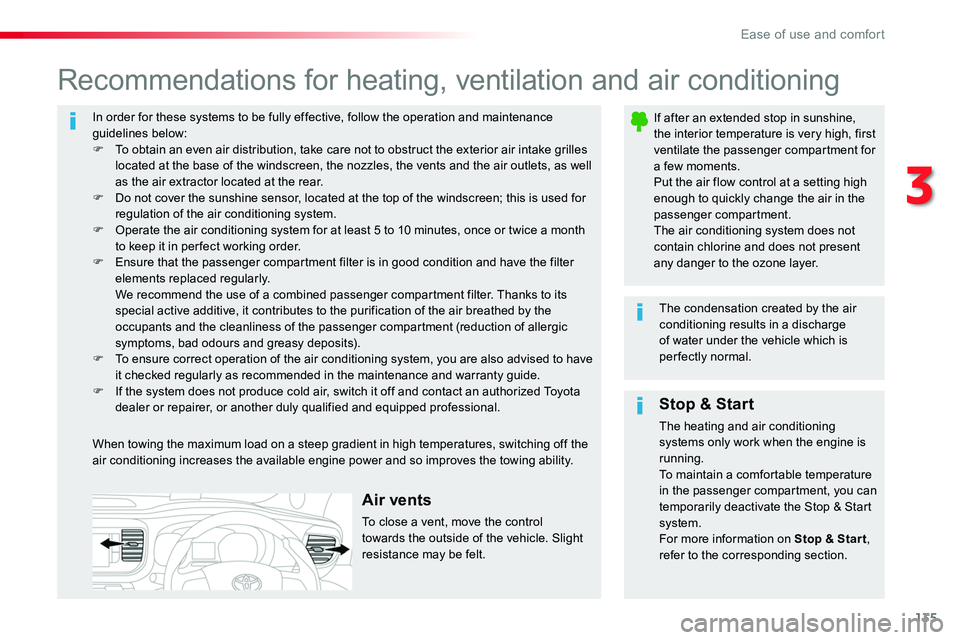
135
In order for these systems to be fully effective, follow the operation and maintenance guidelines below:F To obtain an even air distribution, take care not to obstruct the exterior air intake grilles located at the base of the windscreen, the nozzles, the vents and the air outlets, as well as the air extractor located at the rear.F Do not cover the sunshine sensor, located at the top of the windscreen; this is used for regulation of the air conditioning system.F Operate the air conditioning system for at least 5 to 10 minutes, once or twice a month to keep it in per fect working order.F Ensure that the passenger compartment filter is in good condition and have the filter elements replaced regularly. We recommend the use of a combined passenger compartment filter. Thanks to its special active additive, it contributes to the purification of the air breathed by the occupants and the cleanliness of the passenger compartment (reduction of allergic symptoms, bad odours and greasy deposits).F To ensure correct operation of the air conditioning system, you are also advised to have it checked regularly as recommended in the maintenance and warranty guide.F If the system does not produce cold air, switch it off and contact an authorized Toyota dealer or repairer, or another duly qualified and equipped professional.
Recommendations for heating, ventilation and air conditioning
If after an extended stop in sunshine, the interior temperature is very high, first ventilate the passenger compartment for a few moments.Put the air flow control at a setting high enough to quickly change the air in the passenger compartment.
The air conditioning system does not contain chlorine and does not present any danger to the ozone layer.
The condensation created by the air conditioning results in a discharge of water under the vehicle which is per fectly normal.
When towing the maximum load on a steep gradient in high temperatures, switching off the air conditioning increases the available engine power and so improves the towing ability.
Stop & Start
The heating and air conditioning systems only work when the engine is running.To maintain a comfortable temperature in the passenger compartment, you can temporarily deactivate the Stop & Start system.
For more information on Stop & Star t, refer to the corresponding section.
Air vents
To close a vent, move the control towards the outside of the vehicle. Slight resistance may be felt.
3
Ease of use and comfort
Page 280 of 516
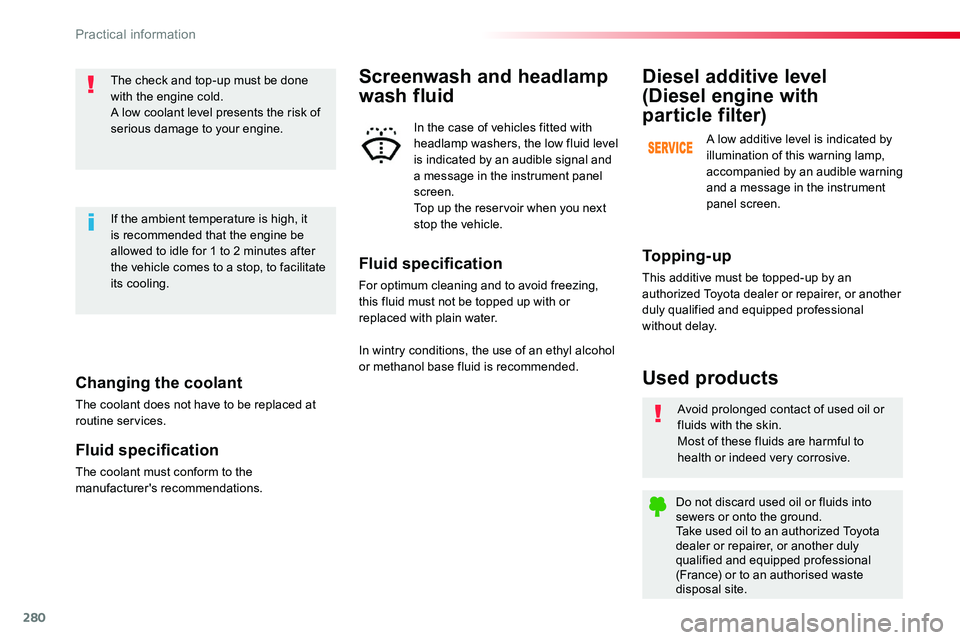
280
Changing the coolant
The coolant does not have to be replaced at routine services.
Fluid specification
The coolant must conform to the manufacturer's recommendations.
The check and top-up must be done with the engine cold.A low coolant level presents the risk of serious damage to your engine.
If the ambient temperature is high, it
is recommended that the engine be allowed to idle for 1 to 2 minutes after the vehicle comes to a stop, to facilitate its cooling.
Avoid prolonged contact of used oil or fluids with the skin.Most of these fluids are harmful to health or indeed very corrosive.
Do not discard used oil or fluids into sewers or onto the ground.Take used oil to an authorized Toyota dealer or repairer, or another duly qualified and equipped professional (France) or to an authorised waste disposal site.
Used products
To p p i n g - u p
This additive must be topped-up by an authorized Toyota dealer or repairer, or another duly qualified and equipped professional without delay.
Diesel additive level
(Diesel engine with
particle filter)
A low additive level is indicated by illumination of this warning lamp, accompanied by an audible warning and a message in the instrument panel screen.
Fluid specification
For optimum cleaning and to avoid freezing, this fluid must not be topped up with or replaced with plain water.
Screenwash and headlamp
wash fluid
In the case of vehicles fitted with headlamp washers, the low fluid level is indicated by an audible signal and a message in the instrument panel screen.Top up the reservoir when you next stop the vehicle.
In wintry conditions, the use of an ethyl alcohol or methanol base fluid is recommended.
Practical information
Page 281 of 516
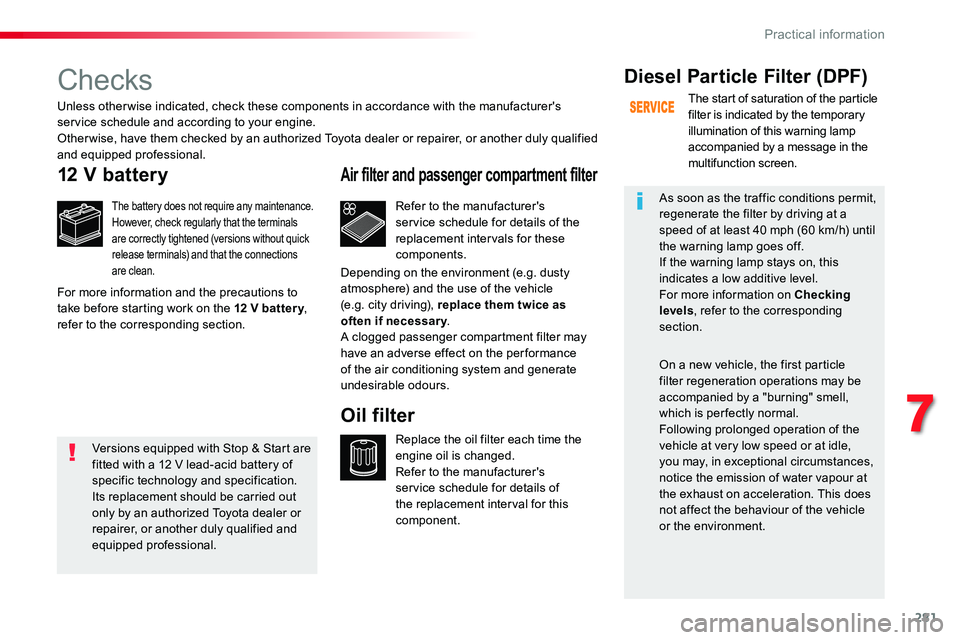
281
Checks
12 V battery
The battery does not require any maintenance.However, check regularly that the terminals are correctly tightened (versions without quick release terminals) and that the connections are clean.
Refer to the manufacturer's service schedule for details of the replacement intervals for these components.
Air filter and passenger compartment filter
Replace the oil filter each time the engine oil is changed.Refer to the manufacturer's service schedule for details of the replacement interval for this component.
Oil filter
Diesel Particle Filter (DPF)
The start of saturation of the particle filter is indicated by the temporary illumination of this warning lamp accompanied by a message in the multifunction screen.
As soon as the traffic conditions permit, regenerate the filter by driving at a speed of at least 40 mph (60 km/h) until the warning lamp goes off.If the warning lamp stays on, this indicates a low additive level.For more information on Checking levels, refer to the corresponding section.
On a new vehicle, the first particle filter regeneration operations may be accompanied by a "burning" smell, which is per fectly normal.Following prolonged operation of the
vehicle at very low speed or at idle, you may, in exceptional circumstances, notice the emission of water vapour at the exhaust on acceleration. This does not affect the behaviour of the vehicle or the environment.
Unless other wise indicated, check these components in accordance with the manufacturer's service schedule and according to your engine.Other wise, have them checked by an authorized Toyota dealer or repairer, or another duly qualified and equipped professional.
For more information and the precautions to take before starting work on the 12 V batter y, refer to the corresponding section.
Depending on the environment (e.g. dusty atmosphere) and the use of the vehicle (e.g. city driving), replace them twice as often if necessar y.A clogged passenger compartment filter may have an adverse effect on the per formance of the air conditioning system and generate undesirable odours.
Versions equipped with Stop & Start are fitted with a 12 V lead-acid battery of specific technology and specification.Its replacement should be carried out only by an authorized Toyota dealer or repairer, or another duly qualified and equipped professional.
7
Practical information
Page 283 of 516

283
AdBlue® and SCR system
for Diesel engines
To assure respect for the environment and conformity with the new Euro 6 emissions standard, without adversely affecting the per formance or fuel consumption of Diesel engines, Toyota has taken the decision to equip its vehicles with an effective system that associates SCR (Selective Catalytic Reduction) with a particle filter (DPF) for the treatment of exhaust gases.
Presentation of the SCR system
Using a fluid called AdBlue® containing urea, a catalytic converter turns up to 85% of nitrogen
oxides (NOx) into nitrogen and water, which are harmless to health and the environment.
The AdBlue® is held in a special tank with a capacity of about 22 litres: this provides a driving range of about 12 500 miles (20 000 km), after which an alert is triggered warning you when the reserve remaining is enough for just 1 500 miles (2 400 km).
During each scheduled service of your vehicle by an authorized Toyota dealer or repairer, or another duly qualified and equipped professional, the AdBlue® tank is refilled in order to allow normal operation of the SCR system.
Once the AdBlue® tank is empty, a system required by regulations prevents starting of the engine.If the SCR is faulty, the level of emissions from your vehicle will no longer meet the Euro 6 standard: your vehicle becomes polluting.In the event of a confirmed fault with the SCR system, you must go to an authorized Toyota dealer or repairer, or another duly qualified and equipped professional as soon as possible: after a running distance of 650 miles (1 100 km), a system will be triggered automatically to prevent engine starting.When filling the tank, the filling rate must not exceed 40 litres per minute.
If the estimated mileage between two services is greater than 12 500 miles (20 000 km), we recommend that you go to an authorized Toyota dealer or repairer, or another duly qualified and equipped professional to have the necessary top-up carried out.
7
Practical information
Page 507 of 516
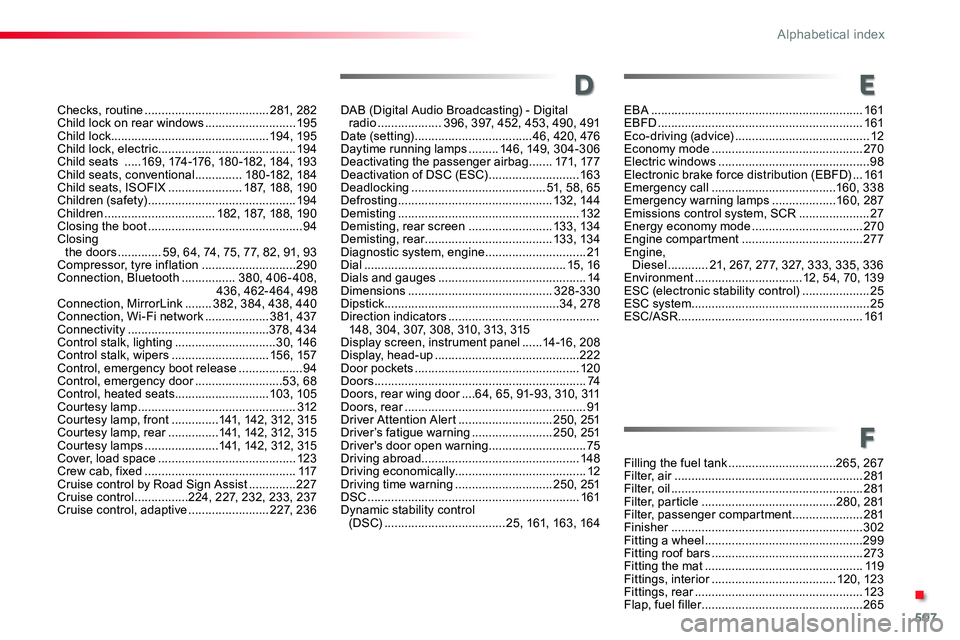
507
Checks, routine .....................................281, 282Child lock on rear windows ...........................195Child lock ...............................................19 4, 195Child lock, electric .........................................19 4Child seats .....169, 174-176, 180 -182, 184, 193Child seats, conventional ..............180 -182, 18 4Child seats, ISOFIX ......................187, 188, 190Children (safety) ............................................19 4Children .................................182, 187, 188, 190Closing the boot ..............................................94Closing the doors .............59, 64, 74, 75, 77, 82, 91, 93Compressor, tyre inflation ............................290Connection, Bluetooth ................380, 406 - 408,436, 462- 464, 498Connection, MirrorLink ........382, 384, 438, 440Connection, Wi-Fi network ...................381, 437Connectivity ..........................................378, 434Control stalk, lighting ..............................30, 146Control stalk, wipers .............................15 6, 157Control, emergency boot release ...................94Control, emergency door ..........................53, 68Control, heated seats ............................103, 105Courtesy lamp ...............................................312Courtesy lamp, front ..............141, 142, 312, 315Courtesy lamp, rear ...............141, 142, 312, 315Courtesy lamps ......................141, 142, 312, 315Cover, load space .........................................123Crew cab, fixed .............................................117Cruise control by Road Sign Assist ..............227Cruise control ................224, 227, 232, 233, 237Cruise control, adaptive ........................227, 236
Filling the fuel tank ................................265, 267Filter, air ........................................................281Filter, oil .........................................................281Filter, particle ........................................280, 281Filter, passenger compartment .....................281Finisher .........................................................302Fitting a wheel ...............................................299Fitting roof bars .............................................273Fitting the mat ...............................................11 9Fittings, interior .....................................120, 123Fittings, rear ..................................................123Flap, fuel filler ................................................265
D
F
E
DAB (Digital Audio Broadcasting) - Digital radio ...................396, 397, 452, 453, 490, 491Date (setting) ...................................46, 420, 476Daytime running lamps .........146, 149, 304-306Deactivating the passenger airbag .......171, 17 7Deactivation of DSC (ESC) ...........................163Deadlocking ........................................51, 58, 65Defrosting ..............................................132, 144Demisting ......................................................132Demisting, rear screen .........................13 3, 13 4Demisting, rear ......................................13 3, 13 4Diagnostic system, engine ..............................21Dial ............................................................15, 16Dials and gauges ............................................14Dimensions ...........................................328-330Dipstick ....................................................34, 278Direction indicators .............................................148, 304, 307, 308, 310, 313, 315Display screen, instrument panel ......14-16, 208Display, head-up ...........................................222Door pockets .................................................120Doors ...............................................................74Doors, rear wing door ....64, 65, 91-93, 310, 311Doors, rear ......................................................91Driver Attention Alert ............................250, 251Driver’s fatigue warning ........................250, 251Driver's door open warning .............................75Driving abroad...............................................148Driving economically.......................................12Driving time warning .............................250, 251DSC ...............................................................161Dynamic stability control (DSC) ....................................25, 161, 163, 164
EBA ...............................................................161EBFD .............................................................161Eco-driving (advice) ........................................12Economy mode .............................................270Electric windows .............................................98Electronic brake force distribution (EBFD) ...161Emergency call .....................................160, 338Emergency warning lamps ...................160, 287Emissions control system, SCR .....................27Energy economy mode .................................270Engine compartment ....................................277Engine, Diesel ............21, 267, 277, 327, 333, 335, 336Environment ................................12, 54, 70, 139ESC (electronic stability control) ....................25ESC system .....................................................25ESC/ASR .......................................................161
.
Alphabetical index